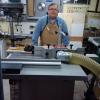I have a new Grizzly GO453Z planer with a spiral head, and I ran some thin strips of pine through (7/8") and I'm getting some snipe in the beginning and end. I can actually hear it take a bit more off at the end. I'm also getting some chips compacted into the board.
In the troubleshooting in the manual, it says that some snipe is expected, but the causes listed are sloped outfeed table, bed rollers set too high, chip breaker not set properly, and unsupported piece. All of the following aren't issues except possibly the bed roller higher. Right now the bed rollers are set at .005", and in the manual it says that you set them between .002 and .020". I don't know if I should set them down to the .002 or if there's potentially another issue. Everything is factory set except the table wings I put on which are good.
I didn't look up the compacted chips in the manual, but I see that it's a common problem from online reviews. It's not a major issue though




 Reply With Quote
Reply With Quote






